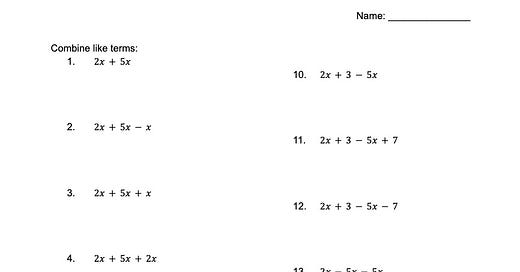A Nice Worksheet
My annual-ish post where I argue that giving students pieces of paper with math problems on them is good
(Last year’s post about a nice worksheet.)
One important component of learning math is solving math problems. One way to facilitate this in a classroom is to put a bunch of math problems on a piece of paper, hand that paper to students, and have students solve the problems. Unfortunately, this is sometimes described pejoratively as a worksheet, as if putting math problems on a piece of paper is boring rote learning, while doing math problems in some other way is exciting, innovative, and progressive.
To be clear, worksheets can be bad. They can be too repetitive, too tedious, too hard, too easy. The goal of giving students math problems is to cause the students to think about mathematical ideas, and to surface ideas and misconceptions for further discussion with the rest of the class. If a worksheet doesn't facilitate those goals it, might deserve the pejorative. The utility of a worksheet depends on the knowledge of the students, the goals of the teacher, and the culture of the classroom.
Here is a nice worksheet:
It's not perfect. It doesn't have multiple variables (like 2x + 3y + 5x + 11y), it doesn't get too complex. This worksheet won’t magically teach your students every single little thing about combining like terms. We were very early in our expressions unit when we did this. But for where we were it was accessible, led to some good conversations, and made for a bit of effective practice.
This worksheet does a few things well.
It starts simple and gets gradually harder. In general, students are happy to do things that make them feel confident and successful. Starting with simpler problems builds momentum.
It's not too long. 18 problems might seem like a lot but these are quick problems. We spent four minutes working and then a few minutes talking about the problems. Most students finished in that time.
It targets a few common misconceptions. Three common mistakes students make with expressions are not knowing what to do with x and -x since there is no written coefficient; mistakenly combining variable and constant terms, like saying 4x + 5 = 9x; and making mistakes with negatives. There are a few specific places in the worksheet where I probe at those misconceptions.
Each problem is connected to the previous problem. This idea comes from variation theory, which you can read more about here if you like. To me, this has two big benefits. First, it makes a bit of repetitive practice more interesting to strong students. Since each problem is only a small variation on the last, students can often figure out the answer more easily by noticing those connections. This can lead to some good mathematical thinking and feels less tedious. Second, it makes the practice more accessible to students who have less confidence. Since each answer can help them solve the next problem, they have a resource to look at and fewer pieces of the problem to think about at once.
It’s also pretty easy to whip up. I can make one of these in a few minutes.
There’s more to math than worksheets, but a good worksheet is a helpful tool for practice, and to set students up to do harder math down the road.





This is perfect, Dylan. “A Nice Worksheet.” Also a little funny, too. I’ve never understood what was so wrong with students practicing problems on a piece of paper.
Excellent post (as usual) Dylan. With the explosion of online teaching/learning the past 5 years, I have HS students who rarely get "worksheets". I think they think they can look at a screen and solve problems in their head, or just "know" which multiple-choice answer is correct (yes even in AP calculus). Some well-constructed worksheets are needed!!